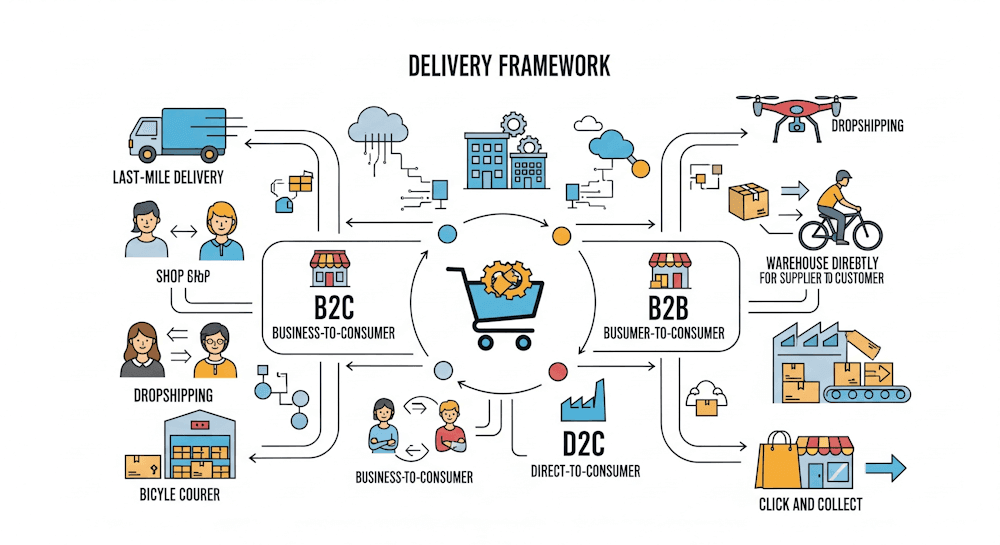E-commerce can be a quick and easy way to do business. It involves selling online via either marketplaces that connect buyers and sellers or standalone websites, using various payment methods.
E-commerce websites have massive appeal because online sales have increased nearly 300% in the past ten years — from 3.3% of total retail sales in the U.S. to 12% of total retail sales.
Consumers like buying online because it’s easy and they can make sound purchase decisions from the comfort of their home. Overall, the convenience and safety of online shopping make E-commerce appealing enough that it has changed traditional business models and given rise to new ones.
Choosing the right E-commerce model involves different considerations. Below, we’ll explain the different types of business models and their features to make it easier for you.
What an E-commerce Business Can Sell
As an E-commerce business, there are a wide variety of items you could sell. Maybe you already have something in mind, or maybe you just know you want to sell something.
1. Physical Goods
A physical good is a tangible item that people can touch and feel — at least once it arrives at the customer’s house. Historically, these have been sold in brick-and-mortar stores, which still account for roughly 90% of retail sales.
If you’re selling a physical product, consider who will make it and how it will be delivered.
Common challenges:
- Storage
- Shipping
- Breakage
- Insurance
Advantages:
- Higher margins
- Strong customer confidence in physical items
2. Digital Goods
Digital goods include e-courses, music tracks, e-books, and software.
Advantages of digital goods:
- No need for storage or shipping
- Instant delivery
- Great margins since one item can be sold unlimited times
Customers love digital goods because they satisfy the modern demand for “I want it, and I want it now.”
3. Services
Services can also be sold online and delivered either online or offline. Examples include:
- Consulting
- Web design
- Handyman services
Additionally, software is now marketed as a service through the SaaS (Software-as-a-Service) model.
E-commerce Business Models and Strategies
There are four common E-commerce business models that define your target audience. These models act as a framework but still leave room for uniqueness. Some businesses even target multiple audiences.
The main models include:
- B2B (Business-to-Business)
- B2C (Business-to-Consumer)
- C2C (Consumer-to-Consumer)
- C2B (Consumer-to-Business)
- B2G (Business-to-Government)
- C2G (Consumer-to-Government)
B2B (Business-to-Business)
A business sells to another business. The buyer may not be the end user — they could be a reseller.
Examples:
- Oracle (database management systems)
- Office supplies, software, HR services
Advantages:
- Larger order sizes = higher revenue
- Recurring orders once relationships are built
- High purchase intent when businesses visit your store
Disadvantages:
- Higher startup capital needed
- Longer sales cycles
- Buyers often negotiate heavily
Fact: Nearly one-third of B2B buyers are millennials, and 75% are part of decision-making, making E-commerce storefronts essential.
B2C (Business-to-Consumer)
This is the most commonly recognized E-commerce model — direct sales to consumers.
Examples: Amazon, Walmart, Target
Market growth:
- $2.3T in sales (2017)
- Expected $4.88T by 2021
Advantages:
- Lower startup costs
- Shorter sales cycles
- Stores open 24/7
- Quick transactions
Challenges:
- Highly competitive space
- High customer expectations (e.g., 64% expect same/next-day delivery)
Trends in B2C:
- Remarketing
- Native advertising
- Mobile apps for payments, tracking, and customer management
C2C (Consumer-to-Consumer)
Customers use marketplaces to sell or exchange products.
Examples:
- Etsy
- eBay
- Bloggers promoting affiliate products
- Shutterstock (C2B-style selling)
Advantages:
- Low cost to start
- Quick to launch
- No need for inventory or heavy investment
Disadvantages:
- Dependent on high traffic volume
- Lower revenue per sale (e.g., 10% from affiliate sales, small margins on stock sites)
Lesser Used Models: B2G & C2G
- B2G (Business-to-Government): Businesses sell services like data storage, IT, or security solutions to the government.
- C2G (Consumer-to-Government): Mostly involves paying taxes or fines online.
How Your E-commerce Company Can Deliver Value
Beyond choosing your audience, think about how your product or service will be delivered.
1. Whitelabeling
Selling a generic product under your own name/packaging.
Advantages:
- Proven demand (you know the product sells well)
Disadvantages:
- Bulk purchasing required
- Risk of unsold stock
Example: Dollar Shave Club (buys razors in bulk, sells under its own brand).
2. Manufacturing
If you have a prototype, you can have it manufactured either domestically or overseas.
Overseas manufacturing (China, Taiwan):
- Cost savings
- Possible challenges: language barriers, lower quality, less dedication to your brand
Read the related article - 5 Examples of Innovative E-commerce Business Models





